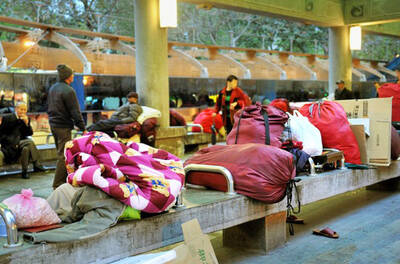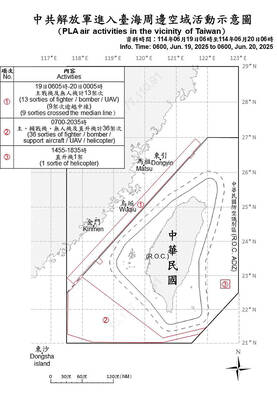The Labor Insurance Fund should last three years longer than previously expected, but the future of the program remains challenging, a report released yesterday showed.
The report on a key source of funding for Taiwan’s main basic pension program, released every three years, said that the NT$1.1 trillion (US$33.57 billion) it had as of the end of November last year would be used up by 2031, three years later than projected in the previous report, but hidden liabilities continue to surge.
Revenues from premiums already fall short of benefits paid out, but many factors would help keep the fund solvent in the near future, Department of Labor Insurance Director Chen Mei-nu (陳美女) said.

Photo: Lee Ching-hui, Taipei Times
Among them were an increase in the number of insured people to 10.1 million, a higher salary basis on which premiums are paid and a premium rate that recently rose to 11.5 percent, she said.
Those factors would increase revenue from premiums by NT$280 billion from last year to 2031, she said.
That estimate assumed a higher rate of return on the fund’s investments of 4.5 percent, which was increased from 4 percent in the previous report because of an actual return rate of 7.5 percent from 2019 to 2023, Chen said.
However, the gains might not be enough to sustain the health of the program, she said.
Workers are required to pay labor insurance premiums based on how much they earn, up to an insured salary of NT$45,800. The premiums cover insurance for occupational hazards, but also support basic retirement pensions for workers other than civil servants, teachers and military personnel, who have their own labor insurance system.
With the nation’s population rapidly aging, benefits have exceeded premium revenues for the past eight years.
Last year, that deficit in the first 11 months of the year totaled NT$60.6 billion, but a government subsidy of NT$130 billion and investment returns of NT$159.5 billion more than covered that shortfall.
However, the report projected that the program would have negative cash flow starting next year as the deficit increased to NT$120 billion, forcing the Department of Labor Insurance to draw from the Labor Insurance Fund.
The worry is that eventually the fund would run out of money and people reliant on labor insurance pension benefits would face deep cuts to their benefits, the report said.
The fund’s hidden liabilities have risen to NT$13.23 trillion, from the previously projected NT$10.29 trillion, because of Taiwan’s changing demographics and more people taking annuities rather than lump-sum retirement payments, it said.
One way to improve the system’s finances would be to increase the salary cap on which premiums are paid to higher than NT$45,800, Chen said.
However, that would also mean higher payouts as the benefit formula is tied to that salary number, she added.
Among the solutions she suggested was for people to work longer to continue contributing labor insurance premiums and for the fund’s investment portfolio to be more diversified to improve investment returns.

A year-long renovation of Taipei’s Bangka Park (艋舺公園) began yesterday, as city workers fenced off the site and cleared out belongings left by homeless residents who had been living there. Despite protests from displaced residents, a city official defended the government’s relocation efforts, saying transitional housing has been offered. The renovation of the park in Taipei’s Wanhua District (萬華), near Longshan Temple (龍山寺), began at 9am yesterday, as about 20 homeless people packed their belongings and left after being asked to move by city personnel. Among them was a 90-year-old woman surnamed Wang (王), who last week said that she had no plans

China might accelerate its strategic actions toward Taiwan, the South China Sea and across the first island chain, after the US officially entered a military conflict with Iran, as Beijing would perceive Washington as incapable of fighting a two-front war, a military expert said yesterday. The US’ ongoing conflict with Iran is not merely an act of retaliation or a “delaying tactic,” but a strategic military campaign aimed at dismantling Tehran’s nuclear capabilities and reshaping the regional order in the Middle East, said National Defense University distinguished adjunct lecturer Holmes Liao (廖宏祥), former McDonnell Douglas Aerospace representative in Taiwan. If

TO BE APPEALED: The environment ministry said coal reduction goals had to be reached within two months, which was against the principle of legitimate expectation The Taipei High Administrative Court on Thursday ruled in favor of the Taichung Environmental Protection Bureau in its administrative litigation against the Ministry of Environment for the rescission of a NT$18 million fine (US$609,570) imposed by the bureau on the Taichung Power Plant in 2019 for alleged excess coal power generation. The bureau in November 2019 revised what it said was a “slip of the pen” in the text of the operating permit granted to the plant — which is run by Taiwan Power Co (Taipower) — in October 2017. The permit originally read: “reduce coal use by 40 percent from Jan.

‘SPEY’ REACTION: Beijing said its Eastern Theater Command ‘organized troops to monitor and guard the entire process’ of a Taiwan Strait transit China sent 74 warplanes toward Taiwan between late Thursday and early yesterday, 61 of which crossed the median line in the Taiwan Strait. It was not clear why so many planes were scrambled, said the Ministry of National Defense, which tabulated the flights. The aircraft were sent in two separate tranches, the ministry said. The Ministry of Foreign Affairs on Thursday “confirmed and welcomed” a transit by the British Royal Navy’s HMS Spey, a River-class offshore patrol vessel, through the Taiwan Strait a day earlier. The ship’s transit “once again [reaffirmed the Strait’s] status as international waters,” the foreign ministry said. “Such transits by